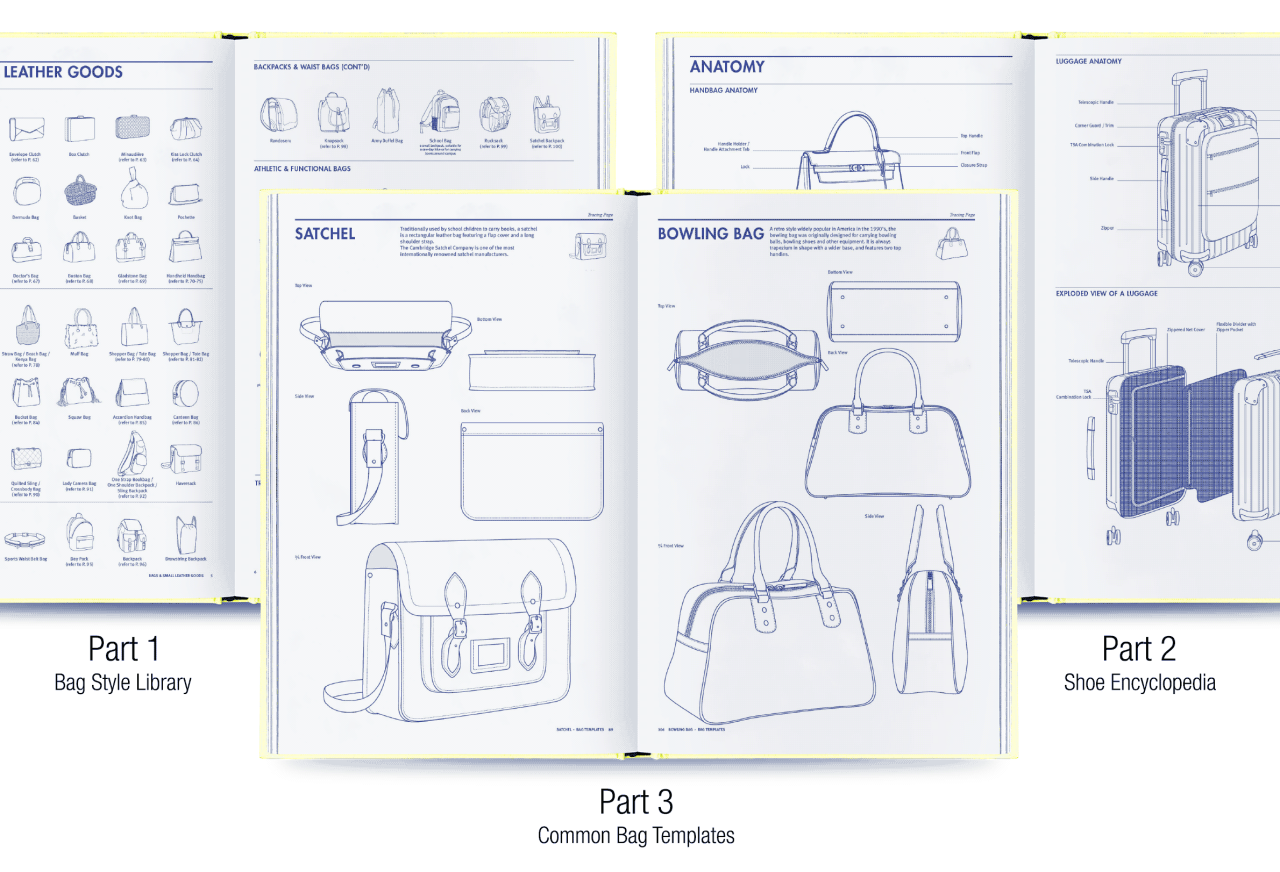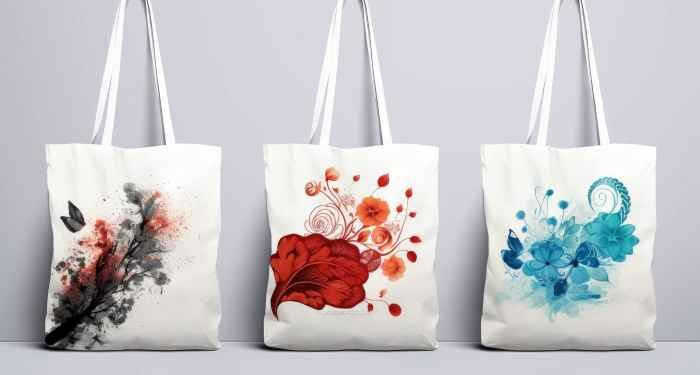Embark on a journey through the realm of bag design, where creativity meets functionality and style. From iconic designs to modern trends, this topic delves deep into the artistry behind crafting the perfect bag.
Delve into the essential elements that shape each bag design, from its structure to the choice of materials, and discover how these elements come together to create a masterpiece of fashion and utility.
Bag Design Overview

In the fashion industry, bag design plays a crucial role in defining a brand's identity and setting trends. It is not only about functionality but also about making a fashion statement and complementing the overall look.
Popular Bag Designs and Features
- Tote Bag: Known for its spacious interior and sturdy handles, perfect for everyday use.
- Clutch: A sleek and elegant design, ideal for formal events or evenings out.
- Backpack: Practical and versatile, suitable for both casual and travel purposes.
Evolution of Bag Design Trends
Bag design trends have evolved over the years, reflecting changes in fashion, technology, and consumer preferences. What was once considered trendy may now be considered outdated, as new styles emerge to meet the demands of the modern fashion landscape.
Elements of Bag Design

When designing a bag, several key elements need to be carefully considered to ensure functionality, usability, and aesthetic appeal. These elements include the shape, size, material, closure, color, texture, and ergonomic design.
Shape, Size, Material, and Closure
- The shape of a bag greatly impacts its overall look and functionality. Whether it's a tote, backpack, crossbody, or clutch, the shape should complement the bag's intended use.
- Size is crucial to ensure the bag can hold all necessary items without being too bulky or too small. Consider the dimensions and compartments needed for different purposes.
- The choice of material can affect the durability, weight, and style of the bag. Leather, canvas, nylon, and other materials offer different characteristics to cater to various needs.
- The closure of the bag, whether it's a zipper, magnetic snap, buckle, or drawstring, should provide security for the contents while also being easy to open and close.
Color and Texture
- Color plays a significant role in the overall design of a bag. It can convey a sense of style, personality, and functionality. Neutral tones offer versatility, while bold colors make a statement.
- Texture adds depth and visual interest to a bag. Smooth leather, textured fabrics, and embellishments can enhance the tactile experience and elevate the design.
Ergonomic Design
- Ergonomics is crucial in creating functional bags that are comfortable to carry for extended periods. Features like padded straps, adjustable handles, and weight distribution help reduce strain on the body.
- Considering the user's comfort and ease of use, ergonomic design ensures that the bag not only looks good but also feels good to wear.
Influential Bag Designers

When it comes to influential bag designers, there are several names that stand out for their innovative and trend-setting designs. These designers have not only shaped the fashion industry but have also influenced the way we perceive and use bags in our daily lives.
Renowned Designers
- 1. Coco Chanel:Known for revolutionizing fashion with her classic quilted handbags, Chanel's designs continue to be iconic and timeless.
- 2. Louis Vuitton:The luxury brand founded by Louis Vuitton is famous for its monogrammed bags and innovative designs that have set trends for decades.
- 3. Prada:Miuccia Prada, the creative force behind Prada, has created a legacy of sleek and modern bags that blend functionality with high fashion.
Designer Collaborations and Trends
Designer collaborations have played a significant role in influencing bag design trends. When top designers team up with popular brands or retailers, it creates a buzz in the fashion world and often leads to the creation of limited-edition, highly sought-after bags.
These collaborations not only bring together different design aesthetics but also introduce innovative concepts that push the boundaries of traditional bag design.
Cultural Influences on Bag Design Aesthetics
Cultural influences play a crucial role in shaping bag design aesthetics. Designers often draw inspiration from various cultures around the world, incorporating unique patterns, materials, and motifs into their designs. Whether it's the vibrant colors of Indian textiles, the intricate craftsmanship of Japanese leatherwork, or the minimalist elegance of Scandinavian design, cultural influences add depth and richness to bag designs, making them more diverse and appealing to a global audience.
Sustainable Bag Design
Sustainable bag design focuses on creating bags that minimize environmental impact and promote ethical practices throughout the production process. It involves using eco-friendly materials, reducing waste, and implementing sustainable practices to ensure a more environmentally friendly product.
Eco-Friendly Materials
When it comes to sustainable bag design, there are various eco-friendly materials that designers can use to reduce the environmental footprint of their products. Some examples include:
- Organic cotton: Grown without the use of synthetic pesticides or fertilizers, organic cotton is a sustainable alternative to conventional cotton.
- Recycled materials: Using materials like recycled polyester or nylon helps reduce the demand for new resources and diverts waste from landfills.
- Cork: A renewable and biodegradable material, cork is often used in bag design for its durability and unique aesthetic.
- Piñatex: Made from pineapple leaf fibers, Piñatex is a cruelty-free alternative to leather that supports sustainable agriculture.
Challenges and Benefits
Implementing sustainable practices in bag design comes with its own set of challenges and benefits:
- Challenges:
- Higher production costs: Using eco-friendly materials and sustainable practices can sometimes result in higher production costs, making it challenging for designers to remain competitive in the market.
- Sourcing reliable suppliers: Finding suppliers that adhere to sustainable practices and provide high-quality eco-friendly materials can be a challenge for designers.
- Consumer education: Educating consumers about the importance of sustainable fashion and the benefits of eco-friendly materials can be a hurdle in promoting sustainable bag design.
- Benefits:
- Reduced environmental impact: Sustainable bag design helps reduce the environmental footprint of the fashion industry by using materials that are renewable, biodegradable, and less harmful to the planet.
- Positive brand image: Embracing sustainable practices can enhance a brand's reputation and attract environmentally conscious consumers who value ethical fashion choices.
- Long-term sustainability: By adopting sustainable practices, designers contribute to a more sustainable future for the fashion industry and help preserve natural resources for future generations.
Closure

As we conclude our exploration of bag design, we reflect on the intricate details that make each bag unique. From sustainable practices to cultural influences, the world of bag design continues to evolve, offering endless possibilities for innovation and creativity.
FAQ Compilation
What role does color play in enhancing bag design?
Color is a crucial element in bag design as it can evoke emotions, make a statement, and complement the overall look of the bag.
Why is ergonomic design important in creating functional bags?
Ergonomic design ensures that bags are not only stylish but also comfortable and practical for everyday use, considering the user's comfort and convenience.
How have designer collaborations influenced bag design trends?
Designer collaborations bring fresh perspectives and innovative ideas to bag design, leading to unique and trend-setting creations that resonate with fashion enthusiasts.













